Troy Herfoss Interview
Trev – So Herf, a pretty successful first outing in America. Tell us, what is it like to ride the Bagger?
Herfoss – “Thanks, Trev. It was a crazy experience. I will explain it like this. It’s like if you’ve raced flat track before, it’s like racing on the best oil-track surface you’ve ever ridden on, with more grip.
“At some stages of the race, it feels like it’s halfway between road-racing and racing on hard-packed flat tracks.
“But essentially, it’s just a road bike. It handles, and we set the bike up similar. Charlie (Herf’s Crew Chief) and I talk about the same issues, and it’s all about doing the most you can with the grip you’ve got. It’s just that these big bikes move around a lot more.”
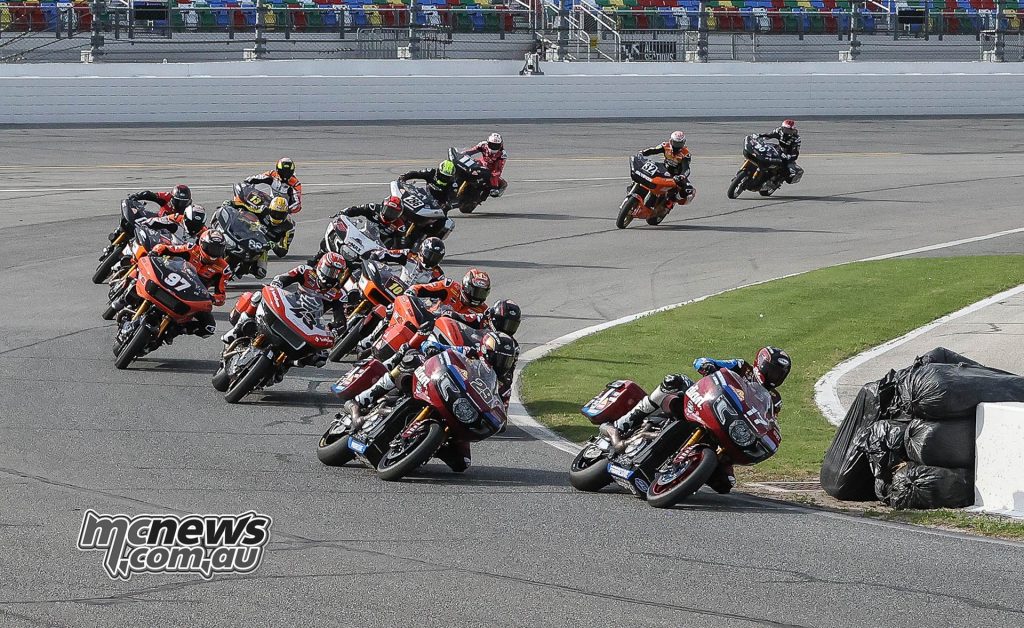
Trev – Now, to try and drill down into the nitty-gritty, a little bit of what it takes for you to transition to riding the Bagger, to help us to try and get a bit of an understanding of what they are like to ride and race. I can’t imagine you can use that much foot input and the control is pretty much all done through the ‘bars? They have huge tyre-turning torque, but also a lot of reciprocating weight swinging around in those crankcases, thus I wouldn’t imagine they would be hugely responsive to gentle amounts of throttle-control while sliding, simply due to the inertia of the engine. Is that the case? Do they rely a fair bit on electronics? Do you actively use the rear brake to help slow up that engine-mass and help you to put weight-transfer through to the front?

Herfoss – “There are no electronics. We can take torque out of the bike, but there’s no actual real help from any electronic aids. It’s got a slipper clutch, which makes life a bit easier.
“The funny part about the physical side, the bike is so heavy, it wouldn’t matter if you had Arnold Schwarzenegger on it. You cannot muscle that bike into changing direction without using the throttle, because it’s just such a big bike.
“I’m not a really strong guy, I don’t spend a lot of time in the gym, but I’m really efficient on the bike, and for me the bike’s easy to ride as long as you know how to use the power, to change direction, basically, and so for me the bike, it’s so surprising. Everyone’s first thought is that, yeah, it must be physically really hard to ride, but honestly, it’s just another road bike.
“You can feel the weight for sure, like when you come off the banks at near 300km/h at Daytona, and you’ve got to hit the brakes a substantial amount earlier than usual (laughs). And that’s one thing you’ve got to be mindful of, switching between classes and bikes, but yeah, the reality is it’s just another bike.
“But I do feel like, for me, to go and try to get stronger is not the way. I’d be far better off just going and trying to work on being more efficient.”
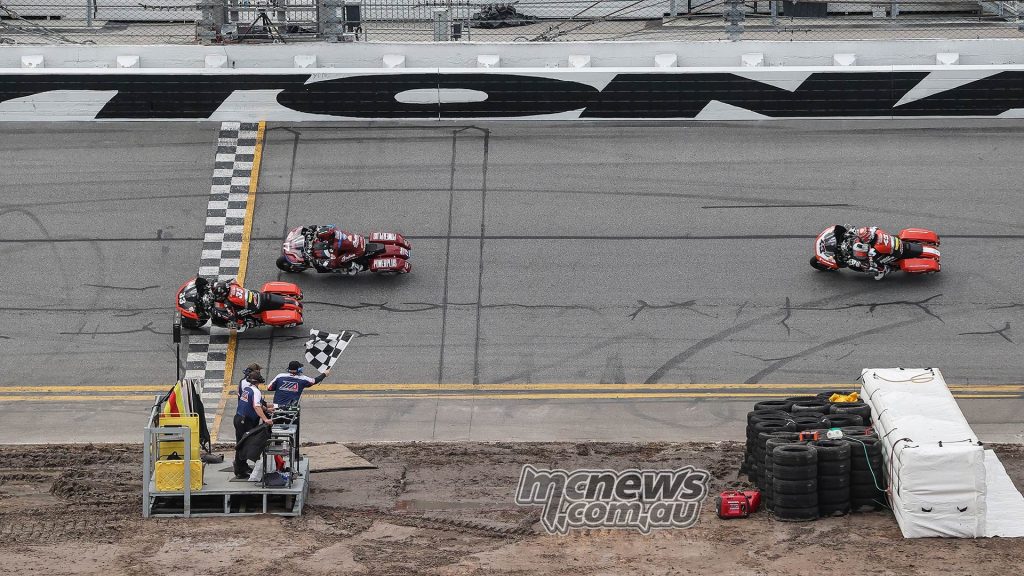
Trev – With my own experience in riding big twins, not the likes of a squillion dollar factory bagger, of course, but, like I say, the amount of weight you feel swinging around in those crankcases is substantial. Obviously, I would imagine these things are engineered to the nth degree and you wouldn’t feel that weight as much, but you surely must still be able to feel that huge amount of inertia? How responsive are they to gentle throttle inputs?

Herfoss – “How do I say… you get a lot from what you give it, basically. Like when you open the throttle a bit, that bike wants to get up and go. And if you try and just bury the throttle and, you know, spin the rear tyre off, if that bike does get grip in that situation, with all that torque, it just ties itself in an absolute knot and you come undone real quick.
“So, I’ve got my foot on the rear brake at all times. Whether I’m using it or not is another thing, but my foot is there, ready to go, because when that bike does get angry, yeah, there’s a lot of weight there and a lot of torque.
“If you even get the smallest little buck and weave and that causes your throttle-hand to jerk a little bit, you get a lot of feedback from that because there’s more torque than I’ve ever experienced before. You’ve got to be just so smooth all the time. It’s all about being smooth and efficient, really.“

Trev – That’s what I guess I’m trying to nut out. So, like when you’re drifting, controlling a slide, are you adjusting that angle of attack with the throttle, and/or rear brake?
Herfoss – “Yeah, it’s definitely the rear brake that is my traction control. So, when I’m using the rear brake correctly, I can get into the throttle hard, like I would with electronics and that way, I can load up the engine. I can get my turning done with the help of the rear brake, and load up the engine with a lot of throttle application. Then, when I’m ready to go, I can come off the rear brake and the bike’s ready to sort of transfer weight.
“The bike’s so hard to get that weight transfer, being so big and long, when you just try and use the throttle on its own, you don’t get that weight to transfer to the rear tyre easily. Therefore, you don’t get the grip, so, yeah, the rear brake is basically my traction control. And then it’s about having enough feel, with grip versus throttle, to not be impatient.
“Because as racers, and even for you, Trev, when you’re on a bike, and you’re trying to go fast, when you feel you’ve set the bike up for an exit, your natural reaction is just to go to full throttle, and with a full-blown Superbike you can actually do that, and the electronics will let that happen efficiently. Whereas with this bike, when I’m setting it up to make an exit, if I just dump the throttle I’ve got (laughs) God knows how much torque and it just will spin up the tyre, and then get into a buck and a weave, and you just lose time straight away. It’s so hard to do, especially when your heart rate is high during a race and the guy in front of you has made a bit of an exit on you. It’s hard to not dump the elbow and try and make up the time, because you just can’t; the bike spins the tyre too easily.”
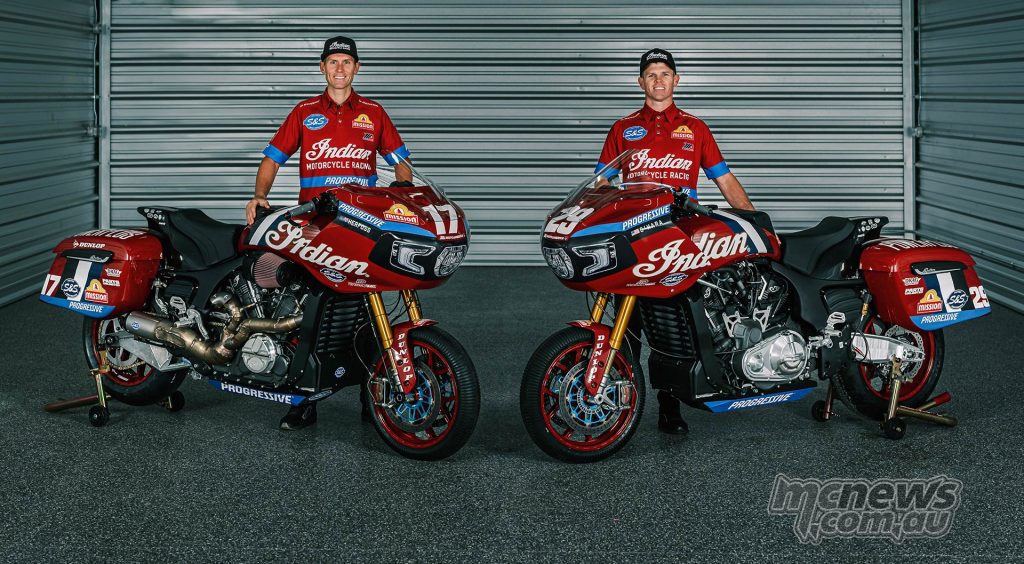
Trev – I know it’s early yet, but do you know if they make different engine specifications for different types of circuits, as in not just tuning the differences by pulling some power out via ignition or injector timing, but do the teams also play around with different crank weight and cams and the like from circuit to circuit?
Herfoss – “I’m not sure. I’ve got a feeling there’s a crank weight specified in the rules. As far as power, I know the bike I rode at Daytona will be the bike I’ll ride at the other tracks. So, yeah, we haven’t played around with moving power, but I think that is something, and it’s definitely worth talking to Charlie about it; that’s certainly something we could do. At the end of the day, they’ve just got too much torque. That’s the reality. So, if we could get the bike to sort of have a bit more up top, then you would definitely go down that route because it’s unbelievable how much torque it has got.”

Trev – How well do they change gears? Is it a slow, deliberate, and carefully managed process, or have they got the set-up working well enough that you can just shuffle your way up and down the box?
Herfoss – “It’s like a lot of the stuff I’ll probably explain in the next few minutes. It works a lot better than you would think. It definitely a big heavy gearbox, so you’ve got to be positive on your down-shifts, But in saying that, the best way to get the most out of electronics on a Superbike is to be patient on your down-shifts as well. So, for me, riding the bike, I guess you don’t have as many shifts in a session, because it’s got so much torque. But there are no real quirks with the gearbox, put it that way. I can just go down through the gears without a clutch. It’s got a blipper on it, and it works just like a normal race bike.”
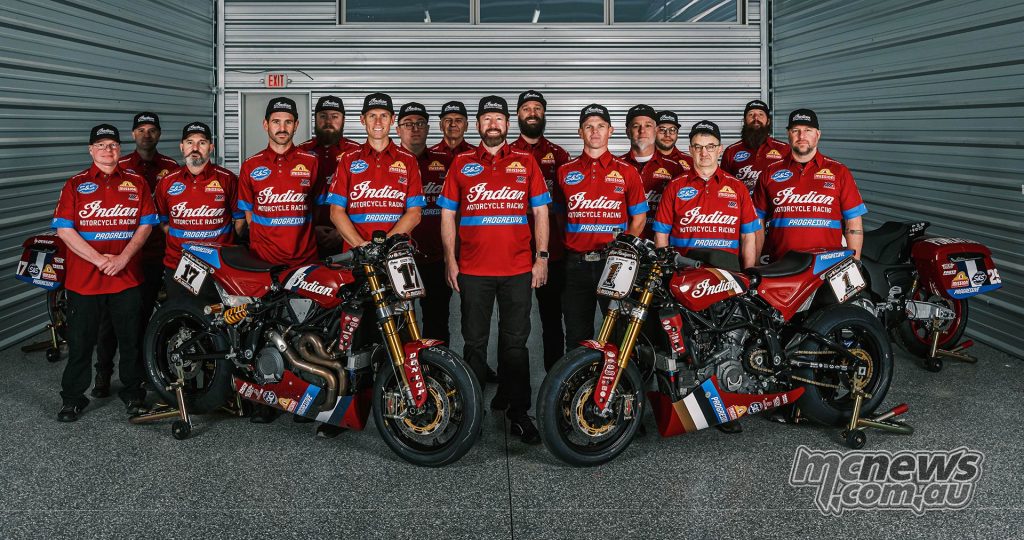
Trev – And the Super Hooligan, a bit like an overgrown Supermotard?
Herfoss – “That bike’s really quirky. It’s got way more trail than I’ve ever experienced. And it’s sort of set up similarly to how I used to ride the Superbike; you don’t use a lot of fork travel, run a heap of trail, and I can just hold the brake on all the way into the middle of the apex, until you’re basically overlapping with the throttle application. I would like to have a set up day on that bike, as I reckon I could make a lot of gains with it. But in that class, that bike versus the other bikes, it seems to handle really well, so maybe that’s just a quirk of these bikes.
“But yeah, before I got to the actual race start, I must say I was feeling a bit uncomfortable. But once I got out there with the other bikes and realised maybe I was trying to ride the bike the way I wanted to be riding it, and not the way it wanted to be ridden. Once I got in the race with the other guys, I realised that, yeah, the bike is strong, with its own little quirks.
“On the street, that bike would be great, like it’s got a lot of torque as well, and you know barring getting in a drag race with a sportsbike, I’m pretty sure that around the mountains, especially up around your place, Trev, I reckon you would just hammer past everyone.”
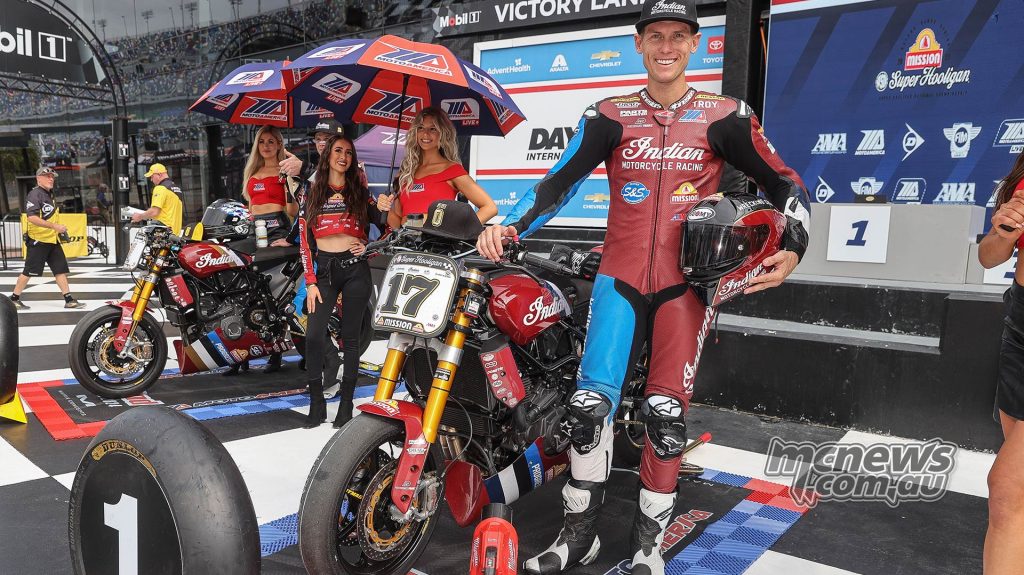
Trev – Over the years, Dunlop seems to be pretty dominant in America. What rubber were you on? I know the Baggers race was reduced from the originally planned eight laps down to six, in order to help the tyres hang together. Just how shagged were they by the end?
Herfoss – “That was a bit disappointing from mine and Charlie’s perspective, because we could get the tyre to last, so it was a bit strange the races were run a bit shorter.
“In the first race, we opted to run the harder Dunlop tyre for safety, because I was just a bit worried about my first race at Daytona. Then for the second race, we ran the softer Dunlop option for both front rear, and had no tyre issues as far as holes or blistering.
“But you can’t believe how much rubber gets laid down. It’s just crazy. Honestly, the main reason for running an eight-lap race versus a full Superbike-length race is just the sheer amount of rubber that comes off the tyre. It’s a lot. And if you’re throttle happy, you can easily use more tyre.”
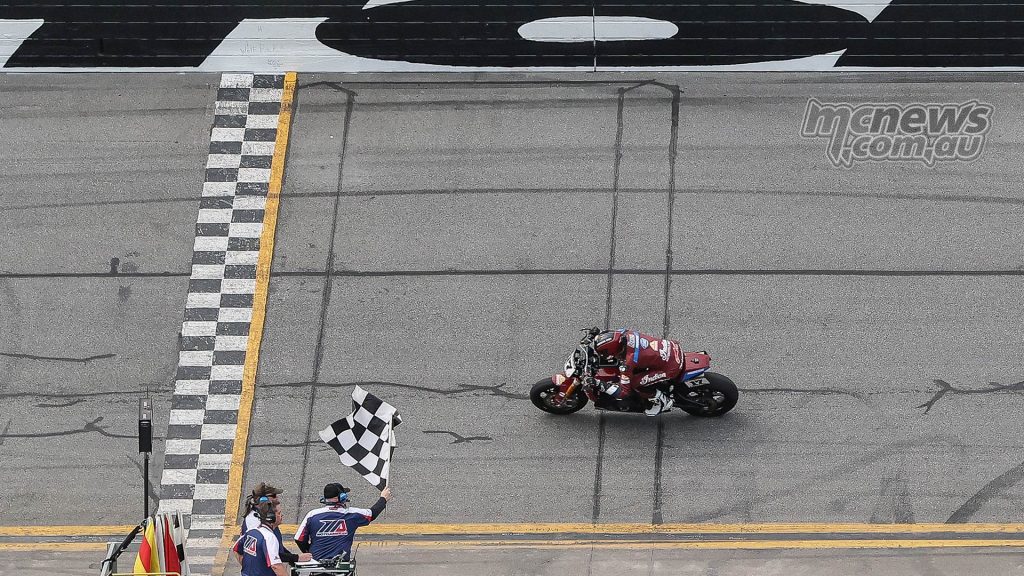
Trev – Now switching focus back to Australia. You are lining up at SMP this weekend for DesmoSport Ducati. Earlier in the year, you didn’t feel as though you would be able to race the full ASBK this season and defend your championship in 2024. Has your thinking changed somewhat on that score?
Herfoss – “Yeah. it has changed, but the same as before, it’s completely up to Ben and his team. Like, we’re really enjoying it; Charlie and I are enjoying being part of the team, and I’ve got Colzo (Ian Collier) across as well, and all the guys at DesmoSport seem to be enjoying it as well. So that’s good, and I think you’ll see in Sydney that Broc’s made big improvements. I felt a bit sorry for him at Phillip Island. He didn’t sort of get the reward. Everyone was so close there. He rode well, but he just didn’t get the points-haul he wanted to. But I think that’s that’s gonna change in the coming rounds. So I feel like we’re making an impact there, and…like you know me, Trev, I just like riding bikes, so I’ve got my hand up to ride whenever I can. It’s keeping me sharp in all areas, so I want to keep racing, and Benny does too. It’s about making it work. It’s hard to run a one-bike team in Australian Superbike. So, it’s about making sure we can do it properly, and if we can, we’ll try and do a few more rounds.“

Trev – Touching on that development plan and helping Broc. Josh Waters leads the championship after winning all three races at Phillip Island, but you are not too far behind. Without any disrespect to Ben and DesmoSport Ducati, the race package Craig McMartin provides his riders seems, over recent times, to have had a bit of an edge. Have you been able to identify anything dramatically different when following Josh or Harry with the way their bike is working, to give you a direction?
Herfoss – “Yeah, we have. I am 100 per cent certain we can go around the track as fast as Josh and Harry. They’re doing something that that we need to figure out. It’s under acceleration, on certain corners, and I’m not saying horsepower as such, it’s just they’re allowing that bike to to move forward, especially off a few key areas at Phillip Island, and we’re so close.
“It was really refreshing actually, to be that close. But moving into Sydney, we’ve got a few ideas on how to get that bike to put the power it’s got down on the ground, and I think that when that happens, we’ll be really competitive.
“If I was here to do the whole championship, I’d be extremely confident, because I left Phillip Island as a potential race winner, which has never been the case, other than when there’s a bit of weather factored in or strange conditions.
“So yeah, I think it was such a good weekend for DesmoSport Ducati, who perhaps had been in a bit of a hole. The bike, and the package, and the team, are clearly good enough. We’re just figuring it out as we go.“
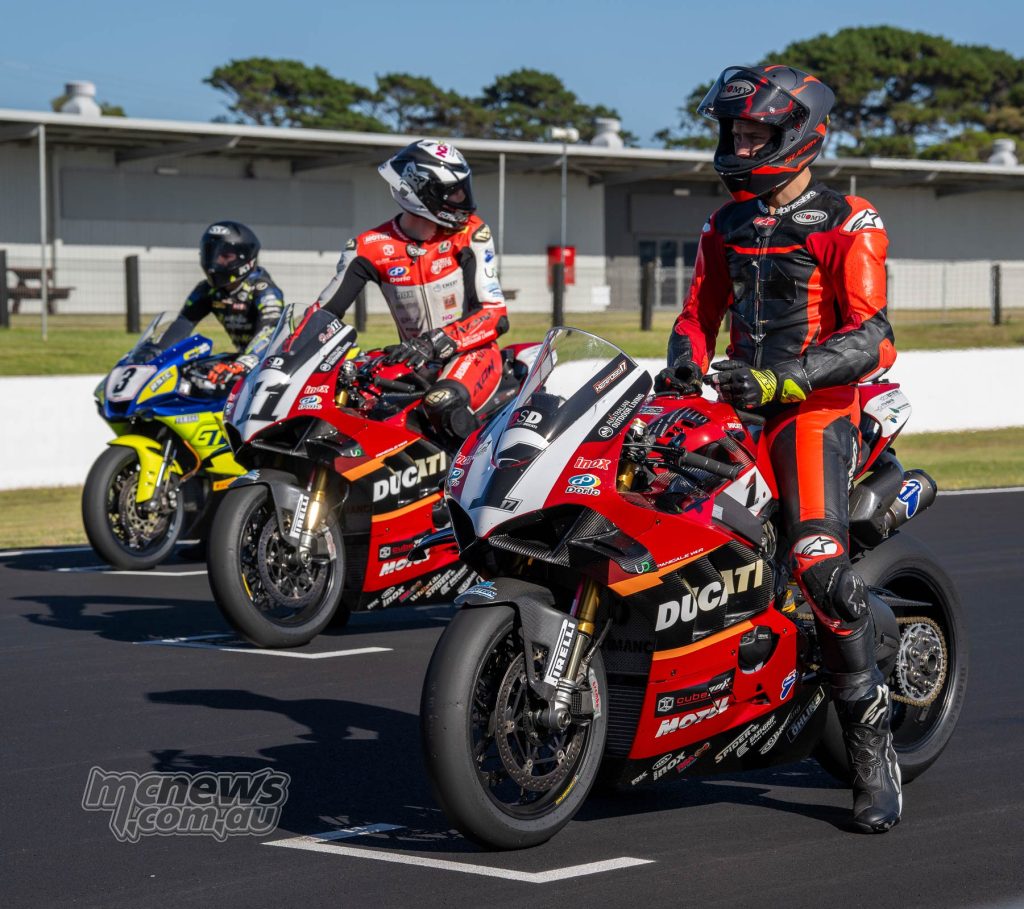
Trev – You touched on the weather there, and it looks like it could be a bit wet this weekend in Sydney. Josh dominated last year at Eastern Creek, and we know he’s an absolute weapon in the wet as well. So that could throw another spanner in the mix if we have some rain this weekend…
Herfoss – “Yeah, I think you’re right. Both Josh and everyone in the team were good last year at Sydney. They were on a different planet compared to everyone else. But I do feel like where we’re trying to catch them guys in the dry, will be similar in the wet. I remember racing with Josh last year in the wet, and yeah, the way that bike can put power on the ground was where he could just just walk away from us when I was on the Honda.
“It’s exciting for a few reasons. I want to compete and try and win races with Benny and show the country that our package is just as good. I believe that the McMartin guys are just doing a bit of a better job, but the package Benny’s got, it’s all there. We just need to figure it out, and I think we will do just that as the year goes on.”
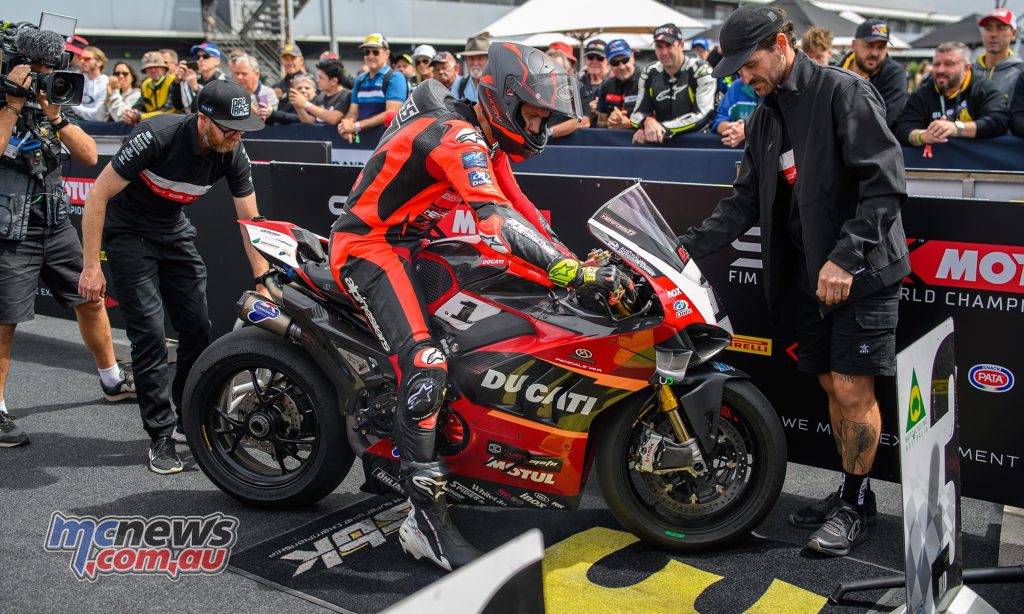
The second round of the 2024 mi-bike Motorcycle Insurance Australian Superbike Championship presented by Motul gets underway this Friday afternoon. The first of the two 13-lap Superbike races will get underway at 1655 on Saturday evening before the second and final contest of the round kicks off under lights at 2110. There are 25 entrants in the superbike category this weekend. For more information click here.
The second round of the MotoAmerica King of the Baggers takes place alongside MotoGP at COTA, before heading to Road Atlanta the following weekend of April 19, where both King of the Baggers and Super Hooligans will be on the MotoAmerica dance card.
ASBK Superbike Championship Points
| Pos | Rider | Bike | Pole | R1 | R2 | R3 | Points |
| 1 | Josh WATERS | Ducati | 1 | 25 | 25 | 12.5 | 63.5 |
| 2 | Harrison VOIGHT | Ducati | 20 | 18 | 10 | 48 | |
| 3 | Troy HERFOSS | Ducati | 18 | 20 | 9 | 47 | |
| 4 | Cru HALLIDAY | Yamaha | 17 | 17 | 8 | 42 | |
| 5 | Anthony WEST | Yamaha | 14 | 16 | 8.5 | 38.5 | |
| 6 | Broc PEARSON | Ducati | 15 | 15 | 6.5 | 36.5 | |
| 7 | Mike JONES | Yamaha | 16 | 9 | 7.5 | 32.5 | |
| 8 | Cameron DUNKER | Yamaha | 13 | 14 | 5.5 | 32.5 | |
| 9 | Max STAUFFER | Yamaha | 11 | 12 | 7 | 30 | |
| 10 | Bryan STARING | Yamaha | 10 | 13 | 6 | 29 | |
| 11 | Glenn ALLERTON | BMW | 12 | 11 | 5 | 28 | |
| 12 | Paris HARDWICK | Kawasaki | 9 | 7 | 2 | 18 | |
| 13 | John LYTRAS | Yamaha | 7 | 6 | 4 | 17 | |
| 14 | Declan CARBERRY | BMW | 6 | 8 | 2.5 | 16.5 | |
| 15 | Arthur SISSIS | Yamaha | 10 | 4.5 | 14.5 | ||
| 16 | Matt WALTERS | Aprilia | 8 | 5 | 13 | ||
| 17 | Josh SODERLAND | Yamaha | 4 | 4 | 3.5 | 11.5 | |
| 18 | Ryan YANKO | Ducati | 3 | 3 | 3 | 9 | |
| 19 | Tim LARGE | Yamaha | 5 | 1.5 | 6.5 | ||
| 20 | Adam SENIOR | Yamaha | 2 | 2 | 0.5 | 4.5 | |
| 21 | Michael KEMP | Yamaha | 1 | 1 | 1 | 3 |
2024 Australian Superbike Championship Calendar
Round 1: Phillip Island Grand Prix Circuit, VIC Feb 23-25- Round 2: Sydney Motorsport Park, NSW Mar 22-23
- Round 3: Queensland Raceway, QLD Apr 26-28
- Round 4: Morgan Park Raceway, QLD Jul 12-14
- Round 5: Phillip Island GP Circuit, VIC Sept 7-8
- Round 6: One Raceway, NSW Oct 4-6
- Round 7: The Bend Motorsports Park, SA Nov 8-10























